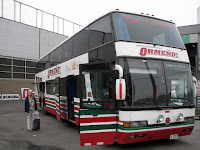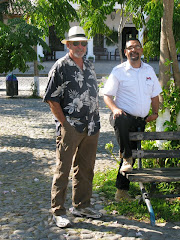Yes, Holy C.R.A.P!!!! We departed Ecuador in late October bound for Panama City. We found ourselves with a great South wind giving us a nice downwind sail to Panama but, after three days the wind changed to coming right out of Panama City so it was the beginning of an uphill slog. The wind quickly went from 10 to 20 to 25 knots in just a few hours and the seas became those short, nasty 4 to 5 footers with foamy tops right on the forward port quarter. It became a really, really rough ride. Probably the roughest we’ve had in ten years of sailing. It was so rough that things were flying out of the cabinets and even our abandon ship bucket flew across the cabin setting off our EPIRB stowed inside. We know that happened because we received a frantic email from my brother asking where we were as he just received a call from Hawaii Coast Guard! The EPIRB didn’t go off long enough to get a location only identification. We couldn’t make any tacks because with the combination of seas, wind and current our tack angle was 150 degrees which gave us a choice of sailing towards Hawaii or Columbia so, we had to motor right into it. After two days of getting beat up we decided to seek refuge in the Perlas Islands, 40 miles from Panama City. The anchorage we chose gave us complete shelter from the harsh winds. As we motored slowly into the anchorage we freed our vacuum packed anchor chain and when we were in position we put the engine in neutral and dropped the anchor. When Jean went to back down on the anchor…. No back down! No transmission! No nada! C.R.A.P! So, we decide that we will sail out of the anchorage at midnight when the tide and current would be in our favor. We left at midnight and took 26 hours and ten tacks to go 28 miles when, at 2am we decided that we would just sail into 30 feet of water and drop the anchor and continue in the morning. Later that morning we tug-boated the last 8 miles into Panama City. We had repair parts shipped down and after two weeks we had things going and headed to El Salvador for fuel and a little rest. Six days later we were at the bar crossing just after high tide. Since I helped pilot over 30 boats across the bar earlier this year I just decided to come in across the same old waypoints. OOPS! The entrance had moved west a little so we bounced on the bottom a few time but the waves lifted us off and we made it OK just in time for Thanksgiving dinner at the hotel.
So, why the Holy CRAP? Since we left Ecuador we’ve had a huge series of failures and problems. Get this:
1 The EPIRB goes off.
2 The hatch in the head starts leaking and soaks everything on the other side of the boat.
3 The propane fitting on the back of the stove cracks and leaks out half a tank of propane.
4 The bulkhead in the head collapses due to dry rot.
5 Transmission thrust plate explodes.
6 Engine raw water pump seal fails.
7 Engine overheats.
8 A vent cap comes off a diesel can on deck and spill diesel on deck.
9 Water maker belt comes off.
10 Water maker High pressure hose comes loose and soaks everything in the water maker room.
11 The high pressure head on the water maker starts to leak.
12 Bimini top tears due to UV degrading.
13 Snap shackle for jib falls overboard due to rust.
14 Propane locker cracks and lets water run inside the boat soaking the carpets.
15 Loose the gas funnel overboard.
16 I need an operation on my big toe in Panama City.
17 Second reef block on boom explodes when putting in reef.
18 Loose the main halyard up the mast.
19 Handle comes off the door to the head.
20 Fresh water pressure pump fails.
21 Hot water pressure relief valve fails and dumps fresh water into bilge.
22 Hand bilge pump diaphragm fails.
23 Circuit breaker for autopilot fails.
HEY, I’m not making this stuff up!!!!
24 Alternator belts comes loose.
25 Diaphragm fails in dinghy air pump.
26 Dinghy gets an air leak.
27 Radar reflector falls off.
28 Stern light fails.
29 Big tear in mainsail
30 One of the computers fails
31 Main fuel bladder develops a leak
32 Rudder cracks in half vertically from bouncing over the bar.
Yeah, that last one is the showstopper. We were supposed to be in Puerto Vallarta before Christmas because I was doing a classical guitar recital on Christmas Day. But, we are here now for a few weeks because we can’t get hauled out until we get a really high tide (around Christmas time). Luckily, we love El Salvador so we can make the best of it.
So, if you think you are having a hard time just read this, you’ll feel a lot better.

 for only $300/month complete with Internet and cable TV. On Christmas Eve we are giving a talk on cruising El Salvador hoping to excite more people into sailing there. Jean and I hope everyone has a nice Christmas and New Year. We’ll be flying back to El Salvador on Jan 8, 2009.
for only $300/month complete with Internet and cable TV. On Christmas Eve we are giving a talk on cruising El Salvador hoping to excite more people into sailing there. Jean and I hope everyone has a nice Christmas and New Year. We’ll be flying back to El Salvador on Jan 8, 2009. for only $300/month complete with Internet and cable TV. On Christmas Eve we are giving a talk on cruising El Salvador hoping to excite more people into sailing there. Jean and I hope everyone has a nice Christmas and New Year. We’ll be flying back to El Salvador on Jan 8, 2009.
for only $300/month complete with Internet and cable TV. On Christmas Eve we are giving a talk on cruising El Salvador hoping to excite more people into sailing there. Jean and I hope everyone has a nice Christmas and New Year. We’ll be flying back to El Salvador on Jan 8, 2009.



















































